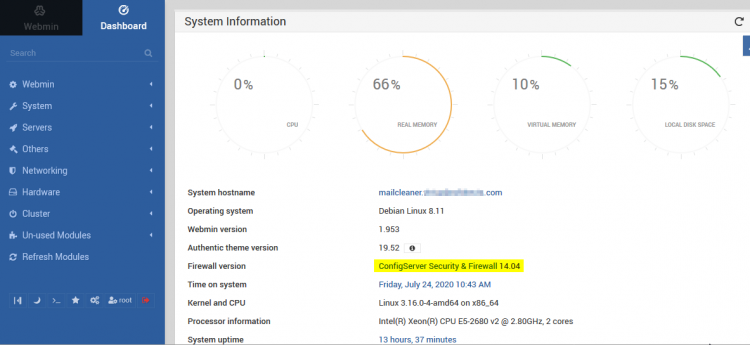User Tools
Table of Contents
MailCleaner CSF Firewall
 Unfinished
Unfinished
See also ConfigServer Security & Firewall (CSF)
See also MailCleaner LetsEncrypt Free SSL
CSF CLI Commands: https://wiki.centos-webpanel.com/csf-firewall-command-line
CSF Docs: https://download.configserver.com/csf/readme.txt
DDoS: https://www.liquidweb.com/kb/basic-dosddos-mitigation-with-the-csf-firewall/
Disable Old Services
Disable Firewall
vim /usr/mailcleaner/etc/init.d/firewall
Add at the top below #! /bin/sh:
# We will use CSF for firewall, so exiting this script logger "MailCleaner firewall disabled in /usr/mailcleaner/etc/init.d/firewall" exit 0
/usr/mailcleaner/etc/init.d/firewall stop systemctl disable firewalld.service
Disable Fail2Ban
vim /usr/mailcleaner/etc/init.d/fail2ban
Add at the top below #! /bin/sh and the initial comments:
# We will use LFD for log file monitoring, so exiting this script logger "MailCleaner fail2ban disabled in /usr/mailcleaner/etc/init.d/fail2ban" exit 0
/usr/mailcleaner/etc/init.d/fail2ban stop systemctl disable fail2ban.service
Install CSF
echo -e "\n# Webmin\ndeb http://download.webmin.com/download/repository sarge contrib" >> /etc/apt/sources.list wget -q http://www.webmin.com/jcameron-key.asc -O- | sudo apt-key add -
apt update && apt install webmin unzip ipset libwww-perl liblist-compare-perl \ liblwp-protocol-https-perl libio-socket-ssl-perl libcrypt-ssleay-perl \ libnet-libidn-perl libio-socket-inet6-perl libsocket6-perl libgd-graph-perl
rm -fv csf.tgz && wget https://download.configserver.com/csf.tgz tar -xzf csf.tgz && cd csf sh install.sh
Test CSF:
perl /usr/local/csf/bin/csftest.pl
Configure Webmin
Admin URL: https://ip.of.csf.host:10000/
Webmin → Webmin Configuration → Webmin Modules → From local file → /etc/csf/csfwebmin.tgz → Install Module
Configure CSF
TESTING = “1” near the top of csf.conf until you have the basic configuration done. Starting CSF and LFD with this setting will run a sanity check of your CSF configuration, but will not add any firewall rules.
TESTING = “0” then enable and start CSF and LFD as shown below.
Hosts to allow:
vim /etc/csf/csf.allow
# Network where you manage your MailCleaner from 10.0.0.0/24 # Management LAN # If you have a MailCleaner cluster server, allow it here # MailCleaner Cluster Ports tcp|in|d=22,3306_3307,5132|s=192.168.1.30 tcp|out|d=22,3306_3307,5132|d=192.168.1.30 udp|in|d=161|s=192.168.1.30 udp|out|d=161|d=192.168.1.30
Hosts for LFD to ignore:
vim /etc/csf/csf.ignore
10.0.0.0/24 # Management LAN 192.168.1.30 # MailCleaner #2
Pre-configured block lists of evildoers:
vim /etc/csf/csf.blocklists
ipset (as documented on this page) and keep track of your system memory usage.
We uncomment (enable) the following lists:
SPAMDROP SPAMDROPV6 SPAMEDROP DSHIELD TOR HONEYPOT CIARMY BFB MAXMIND BDEALL STOPFORUMSPAM STOPFORUMSPAMV6 GREENSNOW
The main configuration file:
vim /etc/csf/csf.conf
MailCleaner Firewall Doc: https://support.mailcleaner.net/boards/3/topics/22-mailcleaner-network-configuration
Some settings to change from the defaults:
TCP_IN = "22,25,80,443" TCP_OUT = "7,22,25,53,80,389,443,636,2703" UDP_IN = "" UDP_OUT = "53,113,123,6277,24441,33434:33523" TCP6_IN = "22,25,80,443" TCP6_OUT = "7,22,25,53,80,389,443,636,2703" UDP6_IN = "" UDP6_OUT = "53,113,123,6277,24441,33434:33523" SYSLOG_CHECK = "600" DENY_IP_LIMIT = "1000" DENY_TEMP_IP_LIMIT = "1000" LF_IPSET = "1" SYNFLOOD = "1" CONNLIMIT = "22;10,25;15,80;30,443;30,587;15,10000;30" PORTFLOOD = "22;tcp;15;300,25;tcp;20;180,80;tcp;20;5,443;tcp;20;5,587;tcp;20;180,10000;tcp;20;5" CONNLIMIT_LOGGING = "1" LF_ALERT_TO = "youradminaddress@yourdomain.tld" LF_ALERT_FROM = "yourvalidfromaddress@yourdomain.tld" LF_PERMBLOCK_COUNT = "3" LF_NETBLOCK = "1" LF_NETBLOCK_COUNT = "3" SAFECHAINUPDATE = "1" DYNDNS = "600" LF_TRIGGER = "3" LF_TRIGGER_PERM = "300" LF_TRIGGER = "0" LF_SELECT = "0" LF_SSHD = "5" LF_SSHD_PERM = "600" LF_FTPD = "10" LF_FTPD_PERM = "600" LF_SMTPAUTH = "10" LF_SMTPAUTH_PERM = "600" LF_EXIMSYNTAX = "10" LF_EXIMSYNTAX_PERM = "600" LF_POP3D = "10" LF_POP3D_PERM = "600" LF_IMAPD = "10" LF_IMAPD_PERM = "600" LF_HTACCESS = "5" LF_HTACCESS_PERM = "600" LF_MODSEC = "5" LF_MODSEC_PERM = "600" LF_BIND = "100" LF_BIND_PERM = "600" LF_SUHOSIN = "5" LF_SUHOSIN_PERM = "600" LF_CXS = "5" LF_CXS_PERM = "600" LF_QOS = "5" LF_QOS_PERM = "600" LF_SYMLINK = "5" LF_SYMLINK_PERM = "600" LF_WEBMIN = "5" LF_WEBMIN_PERM = "600" LF_APACHE_404 = "100" LF_APACHE_403 = "100" LF_APACHE_401 = "100" LF_DISTATTACK = "1" LF_DISTFTP = "5" LF_DISTSMTP = "5" LT_POP3D = "60" LT_IMAPD = "100" LT_SKIPPERMBLOCK = "1" CT_LIMIT = "300"
Configure LFD
LFD is the 'log file daemon'. It monitors log files looking for infractions and suspicious processes. LFD replaces, fail2ban in our use case. LFD is a huge part of why CSF is so effective.
csf.pignore to eliminate warnings from normal system processes, even though These processes can and will change over time with system updates and changes.
The lfd.log will show you the processes it is concerned about:
tail /var/log/lfd.log
Processes you want LFD to ignore:
vim /etc/csf/csf.pignore
Add these lines at the bottom:
cmd:/opt/apache2/bin/httpd -f /usr/mailcleaner/etc/apache/httpd.conf cmd:/usr/bin/python /opt/greylistd/sbin/greylistd /usr/mailcleaner/etc/greylistd/greylistd.conf cmd:SpamHandler cmd:PrefTDaemon cmd:StatsDaemon cmd:MailWatch SQL cmd:spamd child pcmd:MailScanner: .* pcmd:/opt/clamav/sbin/clamd --config-file=/usr/mailcleaner/etc/clamav/clam.* pcmd:/opt/clamav/bin/freshclam --user=clamav --config-file=/usr/mailcleaner/etc/clamav/freshclam.* pcmd:/opt/mysql5/bin/mysqld --defaults-file=/usr/mailcleaner/etc/mysql/my_.* pcmd:/usr/local/bin/spamd --socketpath=/var/mailcleaner/spool/spamassassin/spamd.sock.* pcmd:/usr/local/bin/newsld --socketpath=/var/mailcleaner/spool/newsld/newsld.sock.* pcmd:/opt/exim4/bin/exim -C /usr/mailcleaner/etc/exim/exim_stage.* pcmd:/opt/exim4/bin/exim -C /var/mailcleaner/spool/tmp/exim/exim_stage.* pcmd:/opt/dcc/libexec/dccifd -h/opt/dcc/var.*
Start CSF and LFD
Run this and check for obvious errors:
csf -e && csf -s lfd -e && lfd -s
You can restart CSF and LFD like this:
csf -ra


